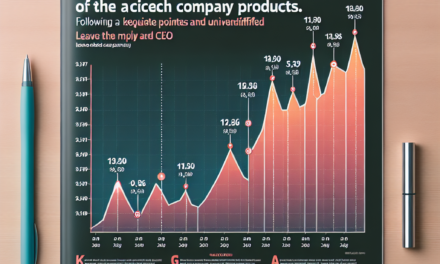“Unlocking Hidden Wealth: The Insight of Financial Analysts in Private Markets”
Introduction
In the intricate world of finance, private markets have long been shrouded in mystery, offering lucrative opportunities yet posing significant challenges for investors seeking to understand their true potential. Financial analysts, armed with advanced analytical tools and a keen understanding of market dynamics, are now delving deeper into these enigmatic realms to unravel the secrets of private-market returns. By dissecting complex investment structures, evaluating risk factors, and interpreting nuanced data, these experts are shedding light on the mechanisms that drive returns in private equity, venture capital, and other non-public investment avenues. Their insights are not only demystifying the private markets but also empowering investors to make informed decisions, ultimately bridging the gap between opacity and opportunity in the pursuit of financial growth.
Understanding Private-Market Returns: A Financial Analyst’s Perspective
In the realm of finance, private-market returns have long been shrouded in mystery, often perceived as the elusive counterpart to their public-market counterparts. Financial analysts, however, are increasingly unraveling the secrets of these returns, providing valuable insights into their dynamics and implications. Understanding private-market returns requires a comprehensive analysis of various factors, including investment strategies, market conditions, and the inherent characteristics of private assets. As financial analysts delve deeper into this complex landscape, they are uncovering patterns and trends that are crucial for investors seeking to optimize their portfolios.
To begin with, private-market returns are fundamentally different from public-market returns due to the nature of the assets involved. Private markets encompass a wide range of investments, including private equity, venture capital, real estate, and infrastructure. These assets are typically less liquid than publicly traded securities, which means they are not as easily bought or sold. Consequently, private-market investments often require a longer time horizon, with returns materializing over several years. This illiquidity premium, as it is known, can lead to higher potential returns, but it also introduces additional risks that must be carefully managed.
Moreover, the performance of private-market investments is heavily influenced by the skill and expertise of the fund managers. Unlike public markets, where performance is largely driven by market trends and economic indicators, private markets rely on the ability of fund managers to identify and capitalize on unique opportunities. This active management approach can result in significant variations in returns, even among similar types of investments. Therefore, selecting the right fund manager is a critical decision for investors looking to maximize their private-market returns.
In addition to the role of fund managers, market conditions also play a pivotal role in shaping private-market returns. Economic cycles, interest rates, and regulatory changes can all impact the performance of private assets. For instance, during periods of economic expansion, private equity and venture capital investments may benefit from increased consumer spending and business growth. Conversely, during economic downturns, these investments may face challenges such as reduced access to capital and lower valuations. Financial analysts must therefore remain vigilant, continuously monitoring market conditions to anticipate potential shifts that could affect private-market returns.
Furthermore, the inherent characteristics of private assets contribute to the complexity of understanding private-market returns. These assets often lack the transparency and standardized reporting found in public markets, making it difficult to obtain accurate and timely information. As a result, financial analysts must rely on a combination of quantitative and qualitative analysis to assess the performance of private-market investments. This involves scrutinizing financial statements, conducting due diligence, and engaging with industry experts to gain a comprehensive understanding of the underlying assets.
In conclusion, the secrets of private-market returns are gradually being unraveled by financial analysts who are dedicated to understanding the intricacies of these investments. By examining factors such as investment strategies, market conditions, and asset characteristics, analysts are providing valuable insights that can help investors navigate the complexities of private markets. As the financial landscape continues to evolve, the role of financial analysts in deciphering private-market returns will remain indispensable, offering a clearer path for investors seeking to achieve their financial goals.
Key Metrics Financial Analysts Use to Evaluate Private-Market Returns
In the realm of finance, private-market investments have long been shrouded in mystery, often perceived as the exclusive domain of sophisticated investors and institutions. However, as interest in these markets grows, financial analysts are increasingly tasked with demystifying the factors that drive returns in this opaque sector. To achieve this, they rely on a set of key metrics that provide insights into the performance and potential of private-market investments. Understanding these metrics is crucial for investors seeking to navigate the complexities of private markets and make informed decisions.
One of the primary metrics used by financial analysts is the Internal Rate of Return (IRR). This measure is pivotal in evaluating the profitability of private-market investments, as it accounts for the time value of money. By calculating the IRR, analysts can determine the annualized rate of return that an investment is expected to generate over its lifespan. This metric is particularly useful in comparing the performance of different investments, as it provides a standardized measure of return that accounts for the timing of cash flows. However, while IRR is a valuable tool, it is not without its limitations. It assumes that interim cash flows are reinvested at the same rate, which may not always be realistic.
In addition to IRR, analysts often examine the Multiple on Invested Capital (MOIC). This metric offers a straightforward measure of an investment’s total return by comparing the total value generated by the investment to the initial capital invested. MOIC is particularly useful for assessing the absolute performance of an investment, as it provides a clear picture of how much value has been created. However, it does not account for the time value of money, which can be a significant drawback when comparing investments with different time horizons.
Another critical metric is the Public Market Equivalent (PME), which allows analysts to compare the performance of private-market investments to public-market benchmarks. By simulating the performance of a comparable public-market investment, PME provides a relative measure of performance that can help investors assess whether private-market investments are delivering superior returns. This metric is particularly valuable in the context of portfolio diversification, as it enables investors to evaluate the opportunity cost of allocating capital to private markets.
Furthermore, financial analysts often consider the Distribution to Paid-In (DPI) ratio, which measures the amount of capital returned to investors relative to the capital invested. This metric is essential for assessing the liquidity of private-market investments, as it indicates how much of the initial investment has been recouped. A high DPI ratio suggests that an investment has generated significant cash returns, which can be particularly appealing to investors seeking liquidity.
In addition to these quantitative metrics, qualitative factors also play a crucial role in evaluating private-market returns. Analysts must consider the broader economic environment, industry trends, and the specific characteristics of the investment, such as the management team’s expertise and the competitive landscape. These qualitative factors can significantly influence the performance of private-market investments and should not be overlooked in the evaluation process.
In conclusion, financial analysts employ a range of key metrics to unravel the secrets of private-market returns. By understanding and applying these metrics, investors can gain valuable insights into the performance and potential of private-market investments. However, it is essential to recognize that no single metric can provide a complete picture. A comprehensive evaluation requires a nuanced approach that considers both quantitative and qualitative factors, enabling investors to make informed decisions in the complex world of private markets.
The Role of Financial Analysts in Private-Market Investment Strategies
In the intricate world of private-market investments, financial analysts play a pivotal role in deciphering the complexities that govern returns. As private markets continue to grow in prominence, understanding the nuances of these investments becomes increasingly crucial for investors seeking to maximize their portfolios. Financial analysts, with their expertise and analytical prowess, are at the forefront of this endeavor, unraveling the secrets that drive private-market returns and shaping investment strategies accordingly.
To begin with, private markets differ significantly from their public counterparts, primarily due to their lack of transparency and liquidity. Unlike public markets, where information is readily available and assets can be easily traded, private markets are characterized by limited data and longer investment horizons. This opacity presents both challenges and opportunities for financial analysts. By meticulously analyzing available data, conducting thorough due diligence, and leveraging their industry knowledge, analysts can identify lucrative investment opportunities that may not be apparent to the untrained eye.
Moreover, financial analysts are instrumental in assessing the risk-return profile of private-market investments. Given the inherent risks associated with these markets, such as illiquidity and valuation uncertainties, analysts must employ sophisticated risk assessment models to evaluate potential investments. By doing so, they help investors understand the trade-offs involved and make informed decisions that align with their risk tolerance and investment objectives. This rigorous analysis is essential in crafting strategies that not only aim for high returns but also mitigate potential downsides.
In addition to risk assessment, financial analysts play a crucial role in portfolio diversification within private markets. Diversification is a fundamental principle in investment strategy, and its importance is magnified in the context of private markets due to their unique characteristics. Analysts, therefore, strive to construct well-balanced portfolios that spread risk across various asset classes, sectors, and geographies. By doing so, they enhance the potential for stable returns while reducing the impact of any single investment’s underperformance.
Furthermore, financial analysts are adept at identifying emerging trends and sectors within private markets that may offer substantial growth potential. As industries evolve and new technologies emerge, analysts must stay abreast of these developments to capitalize on nascent opportunities. Their ability to anticipate shifts in market dynamics and adjust investment strategies accordingly is a testament to their indispensable role in private-market investing.
Another critical aspect of the financial analyst’s role is performance measurement and benchmarking. In private markets, where standardized performance metrics are often lacking, analysts must develop customized benchmarks to evaluate investment success. This involves not only tracking financial returns but also considering qualitative factors such as management effectiveness and strategic alignment. By providing a comprehensive view of performance, analysts enable investors to gauge the effectiveness of their strategies and make necessary adjustments.
In conclusion, financial analysts are integral to the success of private-market investment strategies. Their expertise in data analysis, risk assessment, portfolio diversification, trend identification, and performance measurement equips investors with the tools needed to navigate the complexities of private markets. As these markets continue to evolve, the role of financial analysts will undoubtedly become even more critical, ensuring that investors can unlock the full potential of their private-market investments. Through their diligent efforts, financial analysts unravel the secrets of private-market returns, paving the way for informed and strategic investment decisions.
How Financial Analysts Assess Risk in Private-Market Investments
In the realm of private-market investments, financial analysts play a crucial role in assessing risk, a task that is both complex and nuanced. Unlike public markets, where information is readily available and prices are transparent, private markets are characterized by limited data and less liquidity. This opacity necessitates a more sophisticated approach to risk assessment, requiring analysts to delve deeper into various factors that could impact the potential returns of an investment.
To begin with, financial analysts often start by evaluating the fundamental characteristics of the investment opportunity. This involves a thorough examination of the business model, competitive landscape, and management team. By understanding the core operations and strategic positioning of a company, analysts can identify potential risks that may not be immediately apparent. For instance, a company operating in a highly competitive industry may face risks related to market share erosion, while a business with a unique value proposition might encounter challenges in scaling operations.
In addition to these qualitative factors, analysts also employ quantitative methods to assess risk. One common approach is the use of financial models to project future cash flows and determine the intrinsic value of an investment. By analyzing historical financial data and making assumptions about future performance, analysts can estimate the potential return on investment and identify any discrepancies between the current valuation and the projected value. This process helps in identifying overvalued or undervalued opportunities, thereby mitigating the risk of financial loss.
Moreover, financial analysts must consider macroeconomic factors that could influence private-market investments. Economic indicators such as interest rates, inflation, and GDP growth can have significant implications for the performance of private companies. For example, rising interest rates may increase the cost of borrowing, thereby affecting a company’s profitability and cash flow. Similarly, inflationary pressures could lead to higher input costs, impacting margins and overall financial health. By staying informed about these broader economic trends, analysts can better anticipate potential risks and adjust their investment strategies accordingly.
Another critical aspect of risk assessment in private markets is the evaluation of exit strategies. Given the illiquid nature of private investments, the ability to exit an investment at the right time and at a favorable valuation is paramount. Analysts must consider various exit options, such as initial public offerings (IPOs), mergers and acquisitions, or secondary sales, and assess the likelihood and timing of these events. By understanding the potential exit scenarios, analysts can gauge the risk associated with being unable to liquidate an investment when needed.
Furthermore, financial analysts often rely on scenario analysis and stress testing to evaluate how different conditions could impact an investment. By simulating various economic and market scenarios, analysts can assess the resilience of an investment under adverse conditions. This approach helps in identifying potential vulnerabilities and allows for the development of contingency plans to mitigate risks.
In conclusion, the assessment of risk in private-market investments is a multifaceted process that requires a combination of qualitative and quantitative analysis. Financial analysts must consider a wide range of factors, from company-specific attributes to macroeconomic trends, and employ various tools and techniques to evaluate potential risks. By doing so, they can unravel the secrets of private-market returns and make informed investment decisions that balance risk and reward. Through meticulous analysis and strategic foresight, financial analysts play an indispensable role in navigating the complexities of private-market investments.
Financial Analysts’ Techniques for Forecasting Private-Market Returns
In the realm of finance, the allure of private markets has grown significantly, drawing the attention of investors eager to capitalize on opportunities beyond the public sphere. However, the opaque nature of private markets presents unique challenges for financial analysts tasked with forecasting returns. Unlike public markets, where data is abundant and readily accessible, private markets require analysts to employ a variety of sophisticated techniques to unravel their secrets. By leveraging a combination of historical data analysis, qualitative assessments, and advanced modeling, financial analysts strive to provide accurate forecasts that guide investment decisions.
To begin with, historical data analysis serves as a foundational tool for analysts. Although private markets lack the transparency of their public counterparts, analysts can still glean valuable insights from historical performance data of similar assets or sectors. By examining past trends, analysts can identify patterns and correlations that may inform future performance. This approach, however, is not without its limitations, as historical data in private markets is often sparse and inconsistent. Consequently, analysts must exercise caution and supplement their findings with other techniques to ensure robust forecasts.
In addition to historical data, qualitative assessments play a crucial role in forecasting private-market returns. Analysts often conduct in-depth evaluations of the management teams, business models, and competitive landscapes of private companies. By understanding the qualitative aspects of a company, analysts can better assess its potential for growth and profitability. This involves scrutinizing factors such as leadership experience, strategic vision, and market positioning. Furthermore, analysts may engage with industry experts and stakeholders to gain a deeper understanding of the nuances that could impact a company’s performance. These qualitative insights are invaluable, as they provide context that pure quantitative analysis might overlook.
Moreover, advanced modeling techniques have become indispensable in the toolkit of financial analysts. With the advent of sophisticated software and computational power, analysts can now build complex models that simulate various scenarios and predict potential outcomes. These models often incorporate a range of variables, including macroeconomic indicators, industry trends, and company-specific data. By running simulations, analysts can assess the sensitivity of private-market returns to different factors, thereby enhancing the accuracy of their forecasts. However, it is important to note that models are only as good as the assumptions they are based on. Therefore, analysts must continuously refine their models and update them with the latest data to maintain their relevance.
Transitioning from traditional methods, some analysts are also exploring the potential of machine learning and artificial intelligence in forecasting private-market returns. These technologies offer the ability to process vast amounts of data and identify patterns that may not be immediately apparent to human analysts. By leveraging machine learning algorithms, analysts can enhance their predictive capabilities and uncover insights that were previously unattainable. Nevertheless, the integration of these technologies into the forecasting process is still in its nascent stages, and analysts must carefully balance the benefits with the challenges of implementation.
In conclusion, forecasting private-market returns is a complex endeavor that requires a multifaceted approach. Financial analysts must skillfully combine historical data analysis, qualitative assessments, and advanced modeling techniques to navigate the intricacies of private markets. As technology continues to evolve, the potential for more accurate and insightful forecasts grows, offering investors a clearer view of the opportunities and risks within this dynamic landscape. Through their diligent efforts, financial analysts play a pivotal role in unraveling the secrets of private-market returns, ultimately guiding investment strategies and contributing to the broader understanding of these elusive markets.
Comparing Public and Private-Market Returns: Insights from Financial Analysts
In recent years, the financial landscape has witnessed a growing interest in private-market investments, prompting financial analysts to delve deeper into the intricacies of private-market returns compared to their public-market counterparts. This exploration is driven by the need to understand the potential benefits and risks associated with private-market investments, which have traditionally been less transparent and more complex than public-market investments. As investors seek to diversify their portfolios and enhance returns, the insights provided by financial analysts are invaluable in navigating these uncharted waters.
To begin with, it is essential to recognize the fundamental differences between public and private markets. Public markets, characterized by their transparency and liquidity, offer investors the ability to buy and sell securities with relative ease. In contrast, private markets are less liquid and often involve investments in private equity, venture capital, and real estate, which are not publicly traded. This lack of liquidity can pose challenges for investors seeking to exit their positions quickly. However, it also presents opportunities for potentially higher returns, as private-market investments are often associated with a premium for their illiquidity.
Financial analysts have identified several factors that contribute to the differences in returns between public and private markets. One key factor is the nature of the companies involved. Private-market investments often target early-stage companies with high growth potential, whereas public-market investments typically involve more established companies with stable earnings. This distinction can lead to higher returns in private markets, as investors are able to capitalize on the growth trajectory of these emerging companies. However, it also introduces a higher level of risk, as these companies may not have a proven track record of success.
Moreover, the valuation methodologies employed in private markets differ significantly from those used in public markets. In public markets, stock prices are determined by supply and demand dynamics, with valuations often influenced by market sentiment and macroeconomic factors. In contrast, private-market valuations are typically based on negotiated agreements between investors and company management, which can result in discrepancies between perceived and actual value. This can create opportunities for savvy investors to identify undervalued assets, but it also requires a deep understanding of the underlying business fundamentals.
Another important consideration is the role of active management in private-market investments. Unlike public markets, where passive investment strategies have gained popularity, private markets often require a hands-on approach. Financial analysts emphasize the importance of conducting thorough due diligence and maintaining close relationships with company management to ensure that investments are aligned with strategic objectives. This active involvement can lead to improved operational efficiencies and value creation, ultimately enhancing returns for investors.
Furthermore, financial analysts highlight the impact of market cycles on private-market returns. While public markets are subject to short-term fluctuations driven by investor sentiment, private markets tend to exhibit more stable performance over the long term. This stability can be attributed to the longer investment horizons and the focus on fundamental value creation in private markets. However, it is crucial for investors to remain vigilant and adapt to changing market conditions, as economic downturns can still affect the performance of private-market investments.
In conclusion, the insights provided by financial analysts into the differences between public and private-market returns offer valuable guidance for investors seeking to navigate the complexities of private-market investments. By understanding the unique characteristics of private markets, including their potential for higher returns, valuation methodologies, and the importance of active management, investors can make informed decisions that align with their financial goals. As the interest in private markets continues to grow, the expertise of financial analysts will remain a critical resource in unraveling the secrets of private-market returns.
The Impact of Economic Trends on Private-Market Returns: A Financial Analyst’s View
In recent years, the private market has garnered significant attention from investors seeking to diversify their portfolios and achieve higher returns. Unlike public markets, private markets are less transparent, making it challenging for investors to fully understand the factors influencing returns. Financial analysts, however, have been diligently working to unravel the secrets of private-market returns, particularly in the context of prevailing economic trends. By examining these trends, analysts aim to provide valuable insights that can guide investment strategies and enhance decision-making processes.
To begin with, economic growth plays a pivotal role in shaping private-market returns. During periods of robust economic expansion, private companies often experience increased demand for their products and services, leading to higher revenues and profitability. This, in turn, can result in attractive returns for investors. Conversely, during economic downturns, private companies may face challenges such as reduced consumer spending and tighter credit conditions, which can negatively impact their performance and, consequently, investor returns. Therefore, understanding the broader economic environment is crucial for financial analysts as they assess potential investment opportunities in the private market.
In addition to economic growth, interest rates are another critical factor influencing private-market returns. Low interest rates can create a favorable environment for private companies by reducing borrowing costs and encouraging investment. This can lead to increased business activity and, ultimately, higher returns for investors. On the other hand, rising interest rates can pose challenges for private companies, particularly those with significant debt obligations. Higher borrowing costs can squeeze profit margins and limit growth prospects, thereby affecting investor returns. Financial analysts closely monitor interest rate trends to evaluate their potential impact on private-market investments.
Moreover, inflation is a key economic trend that financial analysts consider when assessing private-market returns. Inflation can erode purchasing power and increase input costs for private companies, potentially squeezing profit margins. However, some private companies may possess pricing power, allowing them to pass on higher costs to consumers and maintain profitability. Analysts examine the inflationary environment to determine which sectors or companies are better positioned to withstand inflationary pressures and deliver favorable returns.
Furthermore, technological advancements and innovation are reshaping the private market landscape, offering both opportunities and challenges for investors. Companies that successfully leverage technology to enhance their operations or develop new products can achieve significant competitive advantages and drive superior returns. Financial analysts pay close attention to technological trends and their potential impact on private-market investments, seeking to identify companies that are well-positioned to capitalize on these developments.
In addition to these economic trends, geopolitical factors can also influence private-market returns. Political instability, trade tensions, and regulatory changes can create uncertainty and volatility in the private market. Financial analysts assess the geopolitical landscape to identify potential risks and opportunities that may affect private-market investments. By understanding these dynamics, analysts can provide valuable insights to investors seeking to navigate the complexities of the private market.
In conclusion, financial analysts play a crucial role in unraveling the secrets of private-market returns by examining the impact of economic trends. By analyzing factors such as economic growth, interest rates, inflation, technological advancements, and geopolitical dynamics, analysts provide valuable insights that can guide investment strategies and enhance decision-making processes. As the private market continues to evolve, staying informed about these trends will be essential for investors seeking to achieve favorable returns in this dynamic and complex investment landscape.
Q&A
1. **What are private-market returns?**
Private-market returns refer to the financial gains or losses generated from investments in private equity, venture capital, real estate, and other non-publicly traded assets.
2. **Why are private-market returns important?**
They are crucial for investors seeking diversification, potentially higher returns, and access to unique investment opportunities not available in public markets.
3. **How do financial analysts assess private-market returns?**
Analysts use metrics like Internal Rate of Return (IRR), Multiple on Invested Capital (MOIC), and Public Market Equivalent (PME) to evaluate performance.
4. **What challenges do analysts face in evaluating private-market returns?**
Challenges include limited data availability, lack of transparency, valuation difficulties, and the illiquid nature of private investments.
5. **How do private-market returns compare to public-market returns?**
Historically, private markets have offered higher returns than public markets, but they come with higher risk, less liquidity, and longer investment horizons.
6. **What role does due diligence play in private-market investments?**
Due diligence is critical for assessing the viability, risks, and potential returns of private investments, helping investors make informed decisions.
7. **How can investors access private-market opportunities?**
Investors can access these opportunities through private equity funds, venture capital funds, direct investments, or specialized investment platforms.
Conclusion
Financial analysts have increasingly focused on demystifying private-market returns, revealing that these markets often offer unique opportunities for diversification and potentially higher returns compared to public markets. By employing advanced analytical tools and methodologies, analysts have been able to better assess the risk-return profiles of private investments, such as private equity, venture capital, and real estate. Their findings suggest that while private markets can provide substantial returns, they also come with higher risks and less liquidity. Furthermore, the performance of private-market investments is heavily influenced by factors such as manager selection, investment strategy, and market conditions. As a result, investors are advised to conduct thorough due diligence and consider their risk tolerance and investment horizon when venturing into private markets. Overall, the insights provided by financial analysts are crucial for investors seeking to optimize their portfolios by including private-market assets.





